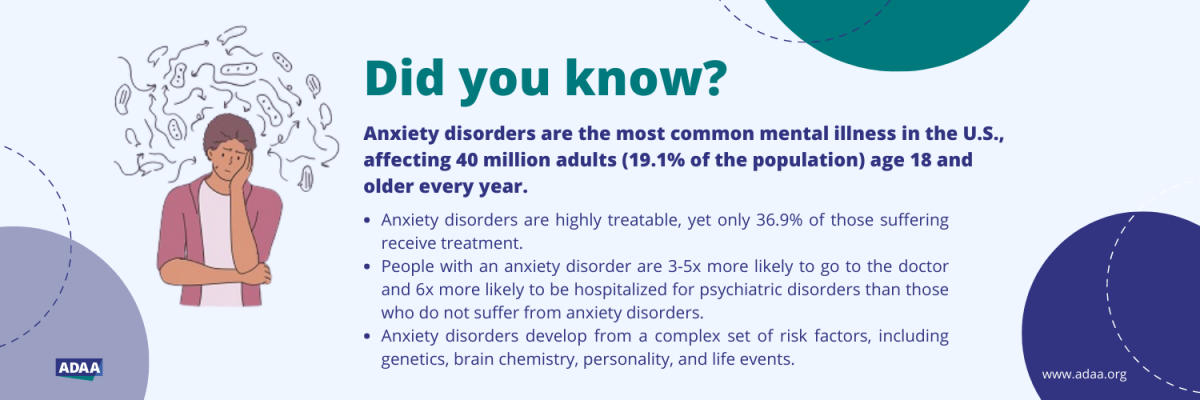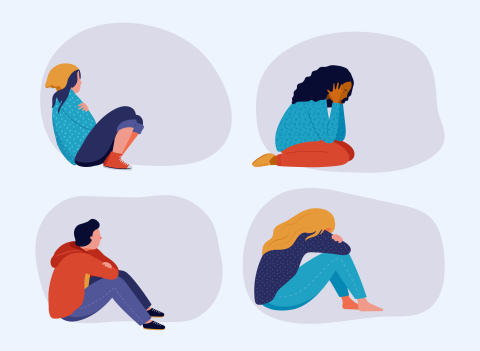
Anxiety Disorders - Facts & Statistics
It's not uncommon for someone with an anxiety disorder to also suffer from depression or vice versa. Nearly one-half of those diagnosed with depression are also diagnosed with an anxiety disorder. Find out more about depression.
Facts and Statistics
Generalized Anxiety Disorder (GAD)
- GAD affects 6.8 million adults or 3.1% of the U.S. population, yet only 43.2% are receiving treatment. NIMH: Generalized Anxiety Disorder.
- Women are twice as likely to be affected as men. GAD often co-occurs with major depression.
Panic Disorder (PD)
- PD affects 6 million adults or 2.7% of the U.S. population. NIMH: Panic Disorders.
- Women are twice as likely to be affected as men.
Social Anxiety Disorder
- SAD affects 15 million adults or 7.1% of the U.S. population. NIMH: Social Anxiety Disorder.
- SAD is equally common among men and women and typically begins around age 13. According to a 2007 ADAA survey, 36% of people with social anxiety disorder report - experiencing symptoms for 10 or more years before seeking help.
Specific Phobias
- Specific phobias affect 19.3 million adults or 9.1% of the U.S. population. NIMH: Specific Phobias.
- Women are twice as likely to be affected than men.
- Symptoms typically begin in childhood; the average age of onset is 7 years old.
- Obsessive-compulsive disorder (OCD) and posttraumatic stress disorder (PTSD) are closely related to anxiety disorders, which some may experience at the same time, - along with depression.
Stress
- Everyone experiences stress and anxiety at one time or another. The difference between them is that stress is a response to a threat in a situation. Anxiety is a reaction to stress. Read APA: Stress in America: A National Mental Health Crisis (Oct 2020)
Obsessive-Compulsive Disorder (OCD)
- OCD affects 2.5 million adults or 1.2% of the U.S. population. NIMH: Obsessive-Compulsive Disorder.
- Women are 3x more likely to be affected than men.
- The average age of onset is 19, with 25% of cases occurring by age 14. One-third of affected adults first experienced symptoms in childhood.
Post-traumatic Stress Disorder (PTSD)
- PTSD affects 7.7 million adults or 3.6% of the U.S. population. NIMH: Post-traumatic Stress Disorder.
- Women are 5x more likely to be affected than men.
- Rape is the most likely trigger of PTSD: 65% of men and 45.9% of women who are raped will develop the disorder.
- Childhood sexual abuse is a strong predictor of the lifetime likelihood of developing PTSD.
Related Illnesses
Many people with an anxiety disorder also have a co-occurring disorder or physical illness, which can make their symptoms worse and recovery more difficult. It’s essential to be treated for both disorders.
Obsessive-compulsive disorder (OCD) and posttraumatic stress disorder (PTSD) are closely related to anxiety disorders, which some may experience at the same time, along with depression.
Read on to learn more about the co-occurrence of anxiety and these disorders:
- Adult ADHD (attention-deficit/hyperactive disorder)
- Bipolar disorder
- BDD (body dysmorphic disorder)
- Eating disorders
- Fibromyalgia
- Headaches
- Irritable bowel syndrome (IBS)
- Sleep disorders
- Stress
- Substance abuse

Children
Anxiety disorders affect 31.9% of adolescents between 13 and 18 years old. Research shows that untreated teenagers with anxiety disorders are at higher risk to perform poorly in school, miss out on important social experiences, and engage in substance abuse.
- See statistics for anxiety disorders among children from the National Institute of Mental Health.
Anxiety disorders also often co-occur with other disorders such as depression, eating disorders, and attention-deficit/hyperactivity disorder (ADHD).
- Childhood anxiety disorders
- Anxiety and depression
- Treatment
- Tips for parents and caregivers
- Anxiety disorders at school
- School refusal
Older Adults
Anxiety is as common among older adults as among the young. Generalized anxiety disorder (GAD) is the most common anxiety disorder among older adults, though anxiety disorders in this population are frequently associated with traumatic events such as a fall or acute illness. Read the best way to treat anxiety disorders in older adults.
Treatment Options
Anxiety disorders are treatable, and the vast majority of people with an anxiety disorder can be helped with professional care. Several standard approaches have proved effective:
Additional Statistics and Resources
- Mental Health America: State of Mental Health in America 2020 Report
- APA: Stress in America: A National Mental Health Crisis (Oct 2020)

















